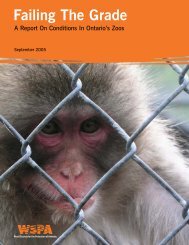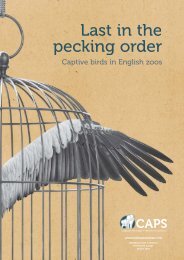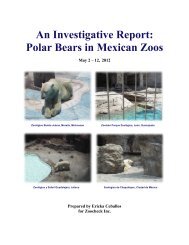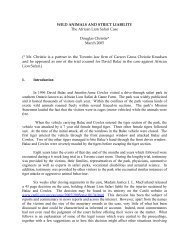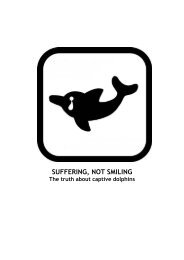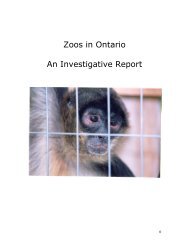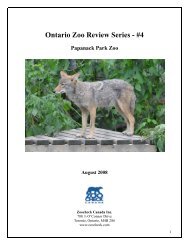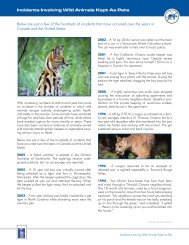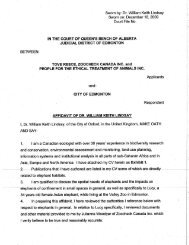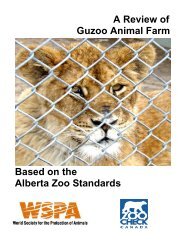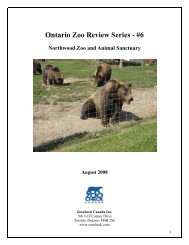STATUS OF BEAR WELFARE
STATUS OF BEAR WELFARE
STATUS OF BEAR WELFARE
Create successful ePaper yourself
Turn your PDF publications into a flip-book with our unique Google optimized e-Paper software.
Status of Bear Welfare in Cherokee, North Carolina<br />
requirements, nor does it provide the bears with the appetitive behavioral stimulation that they<br />
require.<br />
During each of the three public cub feeding sessions at SL, the bear cubs received a baby bottle<br />
(1 cup) of sweetened drink such as Hawaiian Punch, which is extremely high in refined sugars.<br />
This totals to an unhealthy daily dose of 3 cups (photo 7C). These young omnivores need a wide<br />
variety of seasonally appropriate fruits, berries, insects, and vegetation, including willow,<br />
cottonwood, maple, and other species of browse, on a daily basis. On a twice-weekly basis, the<br />
cubs should be getting a whole-carcass feeding, e.g., a chicken or a small mammal such as a<br />
rabbit.<br />
Brown and black bears are largely opportunistic omnivores who consume a wide variety of food<br />
items, including herbs, flowers, nuts, tubers, shoots, berries, and fruits; trees such as willow,<br />
cottonwood, and sugar maple; and grubs and larvae, insects, bird eggs, fish, ungulates, carrion,<br />
etc.<br />
Brown and black bears are highly vegetarian and in captivity should be provided with a highly<br />
vegetarian diet made up of foods that are seasonally available in their natural habitat. For<br />
example, the American black bear should be eating the following:<br />
Season<br />
Early spring<br />
Spring/summer<br />
Late summer/fall<br />
American Black Bear Diet<br />
dried fruits, nuts, branches, some insects, fish, whole carcasses, and<br />
tubers<br />
leaves, tubers, fruits, fish, insects and insect larvae, whole carcasses<br />
fruits, berries, nuts, leafy greens, woody browse and tubers, some fish<br />
and whole carcasses<br />
The brown bear’s diet is similar to that of the American black bear, but it should include<br />
approximately 6 to 10 percent more meat proteins. The diet for both bear species should never<br />
contain more than 30 percent chow. Throughout the winter, denning bears should always have<br />
access to water and a pile of chow.<br />
The diet must also take into consideration each individual bear’s nutritional needs, which are<br />
dictated by a variety of factors, such as age, sex, energy expenditure, season, pregnancy, etc.<br />
For example, a nursing female will need more protein-rich foods. Chow is too high in fat for spring<br />
feeding and possibly too low in fat and natural sugars for fall feeding. High-protein dog chows<br />
have too much protein for omnivorous adult bears and perhaps too little for sub-adult bears.<br />
For the most part, the bears also did not appear to have a consistent source of drinking water<br />
other than the pools, which means that they were drinking their bath water. Several bears at<br />
CSBP were observed drinking from the pools, and metal dishes that were apparently intended for<br />
drinking water were often empty or dirty.<br />
AN INVESTIGATIVE REPORT <strong>OF</strong> CHIEF SAUNOOKE <strong>BEAR</strong> PARK, CHEROKEE <strong>BEAR</strong> ZOO, AND SANTA’S LAND | 26





